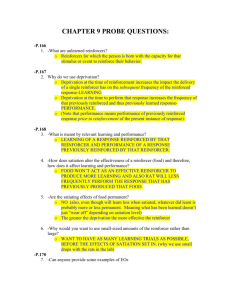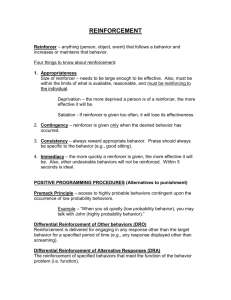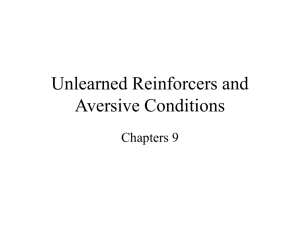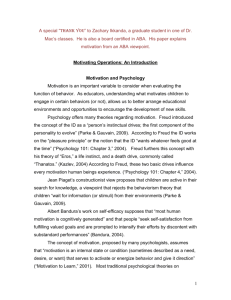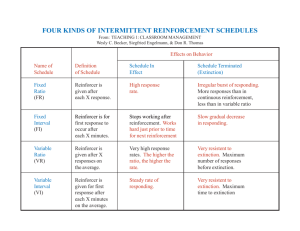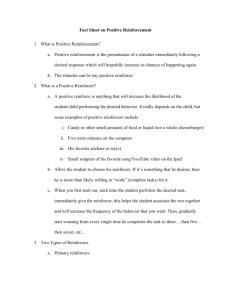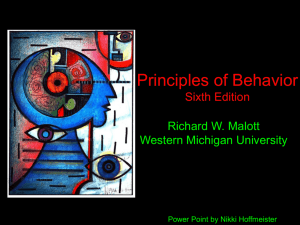effectiveness
advertisement
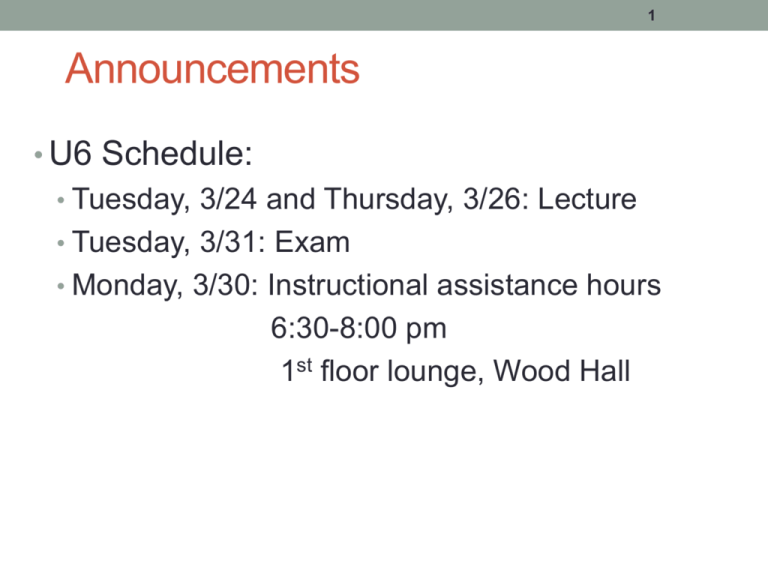
1 Announcements • U6 Schedule: • Tuesday, 3/24 and Thursday, 3/26: Lecture • Tuesday, 3/31: Exam • Monday, 3/30: Instructional assistance hours 6:30-8:00 pm 1st floor lounge, Wood Hall 2 U6: Motivating Operations • This unit focuses exclusively on Motivating Operations and some applied implications of motivating operations • To date, when dealing with operant relations, I have dealt with only the “three-term contingency:” SD:R--->SR/Sr or S∆:R-->Ext • In this unit, I am adding a “fourth term” to the contingency - the motivating variable: MO:SD:R--->SR/Sr or MO:S∆:R-->Ext 3 U6: Motivating Operations, Introduction • Motivating Operations are the way we deal with “motivation” in behavior analysis • Many people outside the field criticize behavior analysis because we do not deal with “motivation;” rather, we are said to analyze behavior only in terms of consequences. • Not so, but the criticism is understandable, because many in the field did, indeed, ignore this very important topic for many years, and did recommend altering behavior exclusively by changing consequences and SDs/S∆s. 4 MOs: Introduction, cont. • Around 1980, Michael introduced the term “establishing operations” to deal with the concept of motivation from a behavioral perspective, and it has now become a widely recognized and important topic (Skinner did deal with motivation, but only in terms of deprivation, satiation, or pre-existing aversive stimulation; he did not have a general term to cover all the variables that have motivating effects) • In 2003, Laraway, Snycerski, Poling & Michael published an article that changed the terminology - that new terminology is more logical and has been adopted • Establishing Operations = Motivating Operations • Vollmer & Iwata in their article use the term EO because the paper was published before this revision in terms 5 Difficult concept: Why? First reason: • The concept is difficult because we often talk about motivation from a “lay” perspective rather than from a scientific perspective • So, you need to learn to talk about it very differently than the way you have no doubt talked about it in the past • Behavior analysts are environmentalists; that is, we look to the environment for causes for behaviors, rather than looking inside the individual so we must talk about motivation the same way - that is, from an environmental, objective perspective 6 Second Reason Why MOs are Difficult • In order to understand the effects that motivating operations have on behavior you must clearly understand: • What reinforcers are and how they affect behavior • What SDs and S∆s are and how they affect behavior • The difference between SDs/S∆s and consequences • Sequencing of material in this class (consequences, then SDs/S∆s, behavioral chains, then multiple effects of stimuli) 7 Michael vs. Malott Terminology • I am using and adopting Michael’s terminology • Malott, in PSY 1400, uses different terminology • You must learn the terminology I am using (Michael’s) • Malott has simplified the concept/definition in order to make it easier to learn, but I think that simplification causes confusion • It is a hard concept to understand, yet essential for understanding behavior; there is no easy way out! (Michael vs. Malott on phone) 8 Introduction to Motivation • In common-sense psychology what a person does is a function of two factors: • knowledge and motivation • For any behavior to occur, a person must know how to do it, and also must want to do it • In traditional psychology wanting to do something has always been defined and discussed as motivation 9 Introduction cont. • Skinner talked about motivation in terms of three types of variables • deprivation, satiation, and pre-existing or antecedent aversive stimulation • Examples • Food deprivation makes a person “want” food • Water satiation makes a person “want” water less • Intense heat or noise makes a person “want” to get rid of the heat or loud noise (pre-existing aversive stimulation) • The above are all environmental variables that precede behavior and affect what a person will do at that particular moment in time; that is, when they are “hungry,” “not thirsty,” or “too hot.” 10 SO 1: The role of MOs in the development of an Sr • To date: NS/SR (repeated pairings) NS will become an Sr • However, that is not the complete story • The appropriate MO for the SR with which the NS is paired must be present when the pairing takes place 11 SO 1: Example, Making a click into an Sr MO (Food deprivation): (must be present, must be MO for food) NS (click)/ SR (food) NS (click) will become an Sr SO 2: Why must the relevant MO be present when the pairing takes place? Otherwise: NS (click)/ NS (food) Why? Food is not a reinforcer if the organism is not food deprived! (note: the MO must be the MO for the SR or Sr: water, then dep; if praise, then “attention dep.”) 12 SO 3: Diagram the role of the MO with respect to the effectiveness of an Sr (testing the Sr) • Not only must the MO for the SR be present when the NS is paired with the SR, but it must be present in order for the Sr to function as a reinforcer MO (food deprivation): R (any response) ---> Sr (click) If the response increases in frequency in the future you know the click has become an Sr Note: the MO of food deprivation must be present for the click to function as a reinforcer. Essentially, the food deprivation becomes the MO for the click. (should look familiar, not logical, click for note) 13 SO 4: State the names of the two main effects that MOs have and be able to describe each • • MOs have the following two simultaneous effects: 1. Value Altering Effect: They alter the reinforcing value of a consequence. That is, they make a consequence more or less reinforcing. (nothing to do with behavior) 2. Behavior Altering Effect: They immediately evoke or suppress behaviors that have resulted in the consequence in the past In other words: MOs • make an individual “want” or “not want” a consequence - in unacceptable lay terms- and • immediately increase or decrease the frequency/likelihood of the response that produced that consequence in the past. (actually, I am going to talk about 4 effects) 14 SO 4: Examples of the cojoint effects of MOs Value Altering and Behavior Altering Effects Examples of MOs that make a consequence more reinforcing and immediately evoke behaviors: • Food deprivation (1) makes food more reinforcing and (2) immediately evokes behaviors that have, in the past, been reinforced with food (e.g., going to the refrig; asking for food). • Being too cold (1) makes warmth more reinforcing and (2) immediately evokes behaviors that have, in the past, been reinforced with warmth (e.g., putting on a jacket). 15 SO 4: More examples of the cojoint effects of Mos Value Altering and Behavior Altering Effects Examples of MOs that make a consequence less reinforcing and immediately suppress behaviors: • Food satiation (1) makes food less reinforcing and (2) immediately suppresses behaviors that have, in the past, been reinforced with food (e.g., suppresses going to the refrig; suppresses asking for food). • Being too warm (1) makes warmth less reinforcing and (2) immediately suppresses behaviors that have, in the past, been reinforced with warmth (e.g., suppresses putting on a jacket). 16 SO 4: Main effects of MOs cont. • MOs can make consequences more or less reinforcing • Value Altering Effect • More reinforcing: Reinforcer Establishing Effect • Less reinforcing: Reinforcer Abolishing Effect • MOs can immediately evoke or suppress behavior that has preceded the relevant reinforcer in the past • Behavior Altering Effect • Evoke behavior: Evocative Effect • Suppress behavior: Abative Effect (descriptiveness of terms) 17 SO 5: Examples from Table 2 of MOs that have a Reinforcer Establishing Effect and an Evocative Effect • Sleep deprivation (1) makes sleep more reinforcing, and (2) evokes behaviors that have, in the past, led to sleep (getting into bed, turning off lights, turning off your cell, etc.) • Being too warm (1) makes becoming cooler reinforcing, and (2) evokes behaviors that have, in the past, led to becoming cooler (taking off a sweater, opening a window). • Pain increase (1) makes a decrease in pain more reinforcing, and (2) evokes behaviors that have, in the past, terminated pain (taking an aspirin). (learn all of the ones in the table, blood loss and salt ingestion; sleep as a physiological state, not a behavior) 18 SO 6: Examples from Table 3 of MOs that have a Reinforcer Abolishing Effect and an Abative Effect • Being too cold (1) makes becoming cooler less reinforcing, and (2) suppresses behaviors that have, in the past, led to becoming cooler. • Sleep satiation (1) makes sleep less reinforcing, and (2) suppresses behaviors that have, in the past, led to sleep. • Pain decrease (1) makes a decrease in pain less reinforcing, and (2) suppresses behaviors that have, in the past, terminated pain. (just like satiation!) 19 SOs 5 & 6: For the exam, be able to answer the following types of questions: • What is the reinforcer establishing effect of being too warm? • What is the evocative effect of an increase in pain? • What is the reinforcer abolishing effect of sleep? • What is the abative effect of activity? (Let’s look at examples - then I will come back to these questions; activity as a physiological state/condition, not a behavior) 20 SOs 5 & 6: Examples and explanation • Food deprivation • Time 1 (in past) MO (food dep): R (going to refrig) SR (food) • Time 2 (in present) MO (food dep): Food deprivation will: • Make food more reinforcing (the reinforcer establishing effect) • Immediately evoke going to the refrigerator (the evocative effect) 21 SOs 5 & 6 Examples and explanation • Food satiation (same Time 1 situation) • Time 1 (in past) MO (food dep): R (going to refrig) SR (food) • Time 2 (in present) MO (food satiation, just eaten a BIG meal): Food satiation will: • Make food less reinforcing (the reinforcer abolishing effect) • Immediately suppress going to the refrigerator (the abative effect) 22 SOs 5 & 6: Examples and explanation • Pain increase • Time 1 (in past) MO (pain/burn): R (put ice on)-->SR (dec. pain) • Time 2 (in present) MO (pain/burn): Pain/burn: • Makes a decrease in pain more reinforcing (the reinforcer establishing effect) • Immediately evokes putting ice on burn (the evocative effect) 23 SOs 5 & 6: Examples and explanation • Pain decrease (same Time 1 as before) • Time 1 (in past) MO (pain/burn): R (put ice on)-->SR (dec. pain) • Time 2 (in present) MO (decrease/termination in pain/burn): Pain/burn decrease: • Makes a decrease in pain less reinforcing (the reinforcer abolishing effect) • Immediately suppresses putting ice on burn (the abative effect) 24 SOs 5 & 6: Sample exam questions on the Value Altering Effect • What is the reinforcer establishing effect of being too cold? • What is the reinforcer establishing effect of a sudden increase in bright sunshine? • What is the reinforcer abolishing effect of being too cold? • What is the reinforcer abolishing effect of activity? Note carefully: It is the consequence that becomes more or less reinforcing, NOT THE BEHAVIOR. Behaviors cannot become more or less reinforcing!! (not talking about activity as a behavior here) 25 SOs 5 & 6: Exam questions on the Behavior Altering Effect • What is the evocative effect of being too cold? • What is the evocative effect of a sudden increase in bright sunshine? • What is the abative effect of being too cold? • What is the abative effect of sleep satiation? NOTE CAREFULLY: It is not correct to say that the abative effect “increases not eating (food sat) or not taking off a sweater (becoming too cold).” Why isn’t it correct?? 26 SO 7: Why are MOs often confused with SDs? How are they similar? How do they differ? • How are they similar? • They both precede behavior • They both evoke operant behavior (but for very different reasons) • How do they differ? • SDs are correlated with the differential availability of a reinforcer • MOs are correlated with the differential effectiveness of a reinforcer (that is, the extent to which the consequence is “reinforcing” at that moment in time) 27 SO 7: SDs vs. MOs, Differential availability vs. differential effectiveness of the consequence (diagrams in article) Rat example: A. MO: (food dep): SD (light on): R (press lever)--> SR (food) B. MO: (food dep): S∆ (light off): R (press lever)-->Ext (no fd) Food is reinforcing, but only available when SD is present C. MO (food dep): SD (light on): R (press lever)--> SR (food) D. MO (food sat): SD (light on): R (press lever)--> Food, but not SR Food is available, but only reinforcing when food dep. 28 SO 7: SDs vs. MOs, cont. Human example (sometimes confusing because of verbal beh): A. MO (food dep): SD (Good Food Here!): R (walk in store)--> SR (food) B. MO (food dep): S∆ (hardware store): R (walk in store)-->Ext (no food) Food is reinforcing, but only available when SD is present C. MO (food dep): SD (Good Food Here!): R (walk in store)--> SR (food) D. MO (food sat): SD (Good Food Here!): R (walk in store)--> Food, but not SR Food is available, but only reinforcing when food dep. 29 SO 8: Srs that can be affected by food deprivation and food satiation • Value Altering Effect of an MO: (review) • The MO makes a consequence more or less reinforcing • Not only does the MO affect how reinforcing SRs are, it also affects how reinforcing all Srs (conditioned reinforcers) are that have been repeatedly paired with the SR in the past. 30 SO 8: Srs that can be affected by food deprivation and satiation • Conditioned Reinforcer Value Altering Effect of an MO • Conceptually, this effect is subsumed under the value altering effect, but I am separating it out to make sure you understand that MOs also affect the reinforcing value of Srs that have been paired with the relevant SR • Thus, food deprivation would not only make food more reinforcing it would also make the following Srs more reinforcing: • Sight and smell of food • Pictures of food • The word “food” • The sight of the refrigerator • Alternatively, food satiation would make all of the above Srs less reinforcing 31 SO 8: Srs that can be affected by other MOs • What is a possible Sr that could be affected by water deprivation and satiation? • How would that Sr be affected by deprivation? • How would that Sr be affected by satiation? • What is a possible Sr that could be affected by being too cold? • How would that Sr be affected? • What is a possible Sr that could be affected by pain from a burn (hot stove)? • How would that Sr be affected? 32 SO 9A: Conditioned Reinforcer Establishing Effect and the Behavior it Influences Rat example (Time 1 training) MO: R ---> Sr/SD R ---> SR Food dep pull chain light on press lever Food Time 2: MO (Food deprivation): 1. The food deprivation will immediately make the light on more reinforcing and… 2. Because the light is more reinforcing, pulling the chain will increase in the future (at time 3) (Food dep will not only make food more rfcng, but also light on: why slide next) 33 SO 9A: Conditioned Reinforcer Establishing Effect and the Behavior it Influences WHY will pulling the chain increase in the future? Time 2: Rat completes the chain MO: R ---> Sr/SD R ---> SR Food dep pull chain light on press lever Food • Because the light was more reinforcing it will increase the frequency of chain pulling in the future when food deprivation is again present at Time 3. Time 3: MO (Food deprivation): R of pulling chain 34 SO 9B: Conditioned Reinforcer Abolishing Effect and the Behavior that is Influenced Rat example (Time 1 training - same as before) MO: R ---> Sr/SD R ---> SR Food dep pull chain light on press lever Food Time 2: MO (Food satiation): 1. What is the conditioned reinforcer abolishing effect that food satiation would have? 2. What behavior will be affected and why? (behavior that will be affected and why – next slide) 35 SO 9B: Conditioned Reinforcer Abolishing Effect and the Behavior it Influences Time 2: Rat makes a “mistake” and pulls chain anyway: MO (Food satiation): R Sr/SD: R SR pull chain light on press lever Fd Because the light on is not reinforcing at the moment due to the food satiation, puling the chain will decrease or at least not increase at Time 3 when the rat is again food satiated: Time 3: MO (Food satiation): R of pulling chain 36 SO 9A: Human Example Time 1 MO: R ---> Sr/SD: R ---> SR headache look on counter sight of advil take advil dec. pain Time 2: MO (headache): What is the conditioned reinforcer establishing effect that the pain from the headache would have? What behavior would be affected and how? 37 SO 9B: Conditioned Reinforcer Abolishing Effect Time 1: same as before MO: R ---> Sr/SD R ---> SR headache look on counter sight of advil take advil dec. pain Time 2: MO (no headache): What is the conditioned reinforcer abolishing effect that no headache would have? What behavior would be affected by this and how? (assume the person looks at the counter, perhaps while washing his/her face or brushing his/her teeth) 38 SO 10: SD Evocative and Abative Effect • Behavior Altering Effect of MOs (review): • MOs immediately evoke or suppress behaviors that have, in the past, resulted in the relevant consequence • This effect is relevant for operant relations that do not have SDs and S∆s • MO (food dep): R (press lever)--> SR (food) • In these operant relations, the MO directly evokes or suppresses the response • However, in operant relations that do have SDs/S∆s, the MO affects the effectiveness of the SD/S∆, which then affects (evokes or suppresses) the behavior 39 SO 10A: SD Evocative Effect, cont. MO (food dep): R (pull chain)-->Sr/SD (light on): R press lever-->SR (food) MO (food dep): • Food deprivation will increase the effectiveness of the light on as an SD, that is make it function effectively as an SD (the SD evocative effect) when the rat got to that point in the chain • The light on would then be more likely to evoke the lever press (because the light on is now an “effective” or “potent” SD) 40 SO 10A: SD Evocative Effect Rat example (Time 1 training) MO: R ---> Sr/SD R ---> SR Food dep pull chain light on press lever Food Time 2: MO (Food deprivation): R (pull chain)--->Sr/SD (light) 1. The food deprivation would make the light on an effective SD, and thus, at this point in the chain, and at that very moment in time 2. The light on would evoke the lever press. 41 SO 10B: SD Abative Effect Rat example (Time 1 training: same as before) MO: R ---> Sr/SD: R ---> SR Food dep pull chain light on press lever Food Time 2: MO (Food satiation): R (pull chain)--->Sr/SD (light) 1. The food satiation would decrease the effectiveness of the light on as an SD, and thus, at this point in the chain, and this very moment in time (assume the rat pulled the chain, which may happen) 2. The light on would be less likely to evoke the lever press. (Diana monkeys from U2) 42 U2: Diana Monkey Token Economy Top Platform SD1: Light on R1: Pull chain ___________ Middle Platform SD1: Top light on Sr/SD2: Bottom light on R2: Pull chain Sr/SD3: Token delivered __________________ Bottom Platform R3: Put token in slot SR: Food ________________ (observed something very interesting: chain was taught under food dep. Monkeys would complete first two links, get the token but keep it. Food satiation. Other Mos came into play: activity deprivation, establishment of social hierarchy. giving tokens, stealing tokens) 43 SO 10: SD Evocative Effect: Human Example Time 1 MO: R ---> Sr/SD: R ---> SR headache look on counter sight of advil take advil dec. pain Time 2: MO (headache): R---> Sr/SD: look on counter sight of advil 1. What is the SD evocative effect that the pain from the headache would have? 2. What behavior would be affected and how? 44 SO 10: SD Abative Effect: Human Example Time 1 MO: R ---> Sr/SD R ---> SR headache look on counter sight of advil take advil dec. pain Time 2: MO (no headache): R ---> Sr/SD look on counter sight of advil 1. What is the SD abative effect that no headache would have? 2. What behavior would be affected and how? 45 SO 11: Four effects of MOs Time 1 MO: R ---> Sr/SD: R ---> SR headache look on counter sight of advil take advil dec. pain Time 2: MO (headache): 1. What is the reinforcer establishing effect of the headache? 2. What is the evocative effect of the headache? 3. A. What is the conditioned reinforcer establishing effect? B. What behavior is affected and how? 4. A. What is the SD evocative effect? B. What behavior is affected and how? 46 SO 11: Four effects of MOs, cont. Time 1 MO: R ---> Sr/SD R ---> SR headache look on counter sight of advil take advil dec. pain Time 2: MO (no headache) 1. What is the reinforcer abolishing effect of no headache? 2. What is the abative effect of no headache? 3. A. What is the conditioned reinforcer abolishing effect? B. What behavior is affected and how? 4. A. What is the SD abative effect? B. What behavior is affected and how? (last slide: next slide Vollmer & Iwata) 47 SO12: Vollmer & Iwata Study Vollmer & Iwata demonstrate how important the MO concept is to applied situations - specifically, when training individuals with developmental disabilities Tim Vollmer Brian Iwata 48 SO12 NFE: Vollmer & Iwata Study • Rationale of study Reinforcement procedures are used extensively in training programs for individuals diagnosed with DDs, yet variation in reinforcer effectiveness both within and across individuals is very common. Can the MO account for at least some of this variation? 49 SO 12 NFE: What is meant by variation in reinforcer effectiveness within and across individuals? Within? A consequence may function as a reinforcer for a behavior of an individual at one point in time, but not function as a reinforcer for that same individual at a different point in time. Food or a hug may be a reinforcer for Johnny at one point in time, but not at another point in time. Across? A consequence may function as a reinforcer for the behavior of one individual but not function as a reinforcer for the behavior of another individual. Food may be a reinforcer for Johnny but not for Suzie. 50 SO 12 NFE: How could MOs be responsible for both types of variation? Within? Johnny may be food deprived at one point in time but not at another point in time. Food would only be reinforcing when Johnny was food deprived. Across? Johnny may be food deprived at a particular point in time but Suzie may not be. Food would only be reinforcing for Johnny. It’s really the within variation that is more interesting. 51 SO 13: Vollmer & Iwata Study, Not for the exam • Conducted three experiments • Food as the reinforcer and thus food deprivation and food satiation as the MOs (unconditioned reinforcer) • Music as the reinforcer and thus music deprivation and satiation as the MOs (sensory reinforcer) • Social attention/interaction as the reinforcer and thus social deprivation and social satiation as the MOs (generalized conditioned reinforcer) 52 SO 14: Vollmer & Iwata Study Summary: All 3 experiments were conceptually the same • Three experimental phases • Baseline • Deprivation • Satiation • Two independent variables that were manipulated (SO14) • The MO (deprivation vs. satiation) • Reinforcement (present or absent) • Baseline: Deprivation present, reinforcement absent • Deprivation: Deprivation present, reinforcement present • Satiation: Satiation present (no dep), reinforcement present 53 Skip to SOs 18-19. • Baseline: Deprivation present, reinforcement absent • Deprivation: Deprivation present, reinforcement present • Satiation: Satiation present (no dep), reinforcement present 18. Response rates during the deprivation phases were always higher than response rates during the satiation phases. Given the above, what variable would account for the higher response rates during the deprivation phases? Deprivation. Reinforcement was provided for responding in both. Deprivation was present during the deprivation phases while satiation was present during the satiation phases. 54 Skip to SOs 18-19. • Baseline: Deprivation present, reinforcement absent • Deprivation: Deprivation present, reinforcement present • Satiation: Satiation present (no dep), reinforcement present 19. Response rates during the deprivation phases were always higher than response rates during baseline. Given the above, what variable would account for the higher response rates during deprivation phases? Reinforcement. Deprivation was present during both phases. Reinforcement was provided for responding only in the deprivation phase. 55 Back to SOs 16 & 17: Experiment 1 • Participants: • Craig, Sam, and Lonny • DV: • # blocks placed in container per minute • IVs: • MO manipulation: Food deprivation or satiation • Reinforcement vs. No reinforcement • Nuts, raisins, dried fruit (health food, no M&Ms!) 56 SOs 16 & 17, cont: Experiment 1 • Baseline phase • Food deprivation: Sessions 30 min before lunch • No reinforcement for putting blocks in container • Deprivation phase: • Food deprivation: Sessions 30 min before lunch • Reinforcement: Rs reinforced on FR3 or FR5 • Satiation phase: • Food satiation: Sessions 15 min after lunch & free access to the edibles for 10 min • Reinforcement: Rs reinforced on FR3 or FR5 (naturally food deprived) 57 58 SO 20: Experiment 3 (No SOs over experiment 2 with music) • Participants: • Donny and Sam (focus on Donny) • DV: • # blocks placed in container per minute • IVs: • MO manipulation: Social deprivation or satiation during pre-experimental sessions • Reinforcement vs. No reinforcement • Verbal praise/interaction vs. no praise/interaction 59 SO 21, cont: Experiment 3 • Baseline phase • Social deprivation: No interaction with E for 15 min before experimental sessions • No reinforcement for putting blocks in container • Deprivation phase: • Social deprivation: Same as above • Reinforcement: Rs reinforced on FR10 • Satiation phase: • Social satiation: Constant interaction with E, noncontingent praise every 15 sec for 15 min before experimental sessions • Reinforcement: Rs reinforced on FR10 60 61 SO 20: Donny’s Interesting Behavior • During the pre-experimental social satiation sessions, Donny began running away from the E, and then began throwing things at the E! • Not only had social interaction become less reinforcing, but the MO of social satiation made (a) the termination of social interaction reinforcing, and (b) evoked behaviors that had, in the past, terminated social interaction. • Yet, during the deprivation phase, the MO of social deprivation made social interaction highly reinforcing. • This clearly demonstrates the power of the MO! 62 SO 20A&B: Donny’s Interesting Behavior. Pre-session Satiation Procedures MO: R ---> Srsocial sat run away no social interaction throw things (Diagram which will help you answer 20A&B – diagram NFE: Why Sr- rather than SR-?) 63 SO 20: Donny’s MOs A. During the pre-session satiation procedures for Donny, what was the conditioned reinforcer establishing effect of social satiation as the MO? Termination of social interaction became reinforcing! B. During the pre-session satiation procedures for Donny, what was the evocative effect of social satiation as the MO? Evoked the behaviors of running away from the E and throwing things at the E, because those behaviors had, in the past, been reinforced by the termination of social interaction with others. (state actual behaviors) 64 SO 20C&D: Donny’s Behavior During the Experimental Sessions in Satiation Phase Time 1 MO: R Sr social dep put blocks in container social praise Time 2 MO: social sat (diagram will help you answer C&D, nfe; questions C&D, next slide; SD issue? Later, if time) 65 SO 20: Donny’s MOs, cont. C. During the experimental sessions for Donny, what was the conditioned reinforcer abolishing effect of social satiation as the MO? It made social interaction less reinforcing D. During the experimental sessions for Donny, what was the abative effect of social satiation as the MO? It suppressed putting the blocks in the container (state the specific behavior) 66 The End • Questions? • Instructional Assistance Hours Monday, 3/30 • 6:30-8:00 pm • Thomas will be there!
